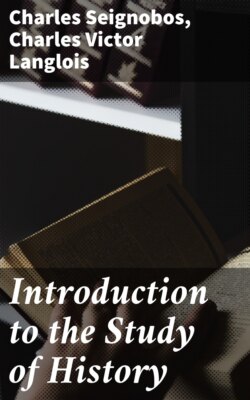Читать книгу Introduction to the Study of History - Charles Victor Langlois - Страница 13
На сайте Литреса книга снята с продажи.
CHAPTER I
ОглавлениеTable of Contents
GENERAL CONDITIONS OF HISTORICAL KNOWLEDGE
We have already stated that history is studied from documents, and that documents are the traces of past events.[54] This is the place to indicate the consequences involved in this statement and this definition.
Events can be empirically known in two ways only: by direct observation while they are in progress; and indirectly, by the study of the traces which they leave behind them. Take an earthquake, for example. I have a direct knowledge of it if I am present when the phenomenon occurs; an indirect knowledge if, without having been thus present, I observe its physical effects (crevices, ruins), or if, after these effects have disappeared, I read a description written by some one who has himself witnessed the phenomenon or its effects. Now, the peculiarity of "historical facts"[55] is this, that they are only known indirectly by the help of their traces. Historical knowledge is essentially indirect knowledge. The methods of historical science ought, therefore, to be radically different from those of the direct sciences; that is to say, of all the other sciences, except geology, which are founded on direct observation. Historical science, whatever may be said,[56] is not a science of observation at all.
The facts of the past are only known to us by the traces of them which have been preserved. These traces, it is true, are directly observed by the historian, but, after that, he has nothing more to observe; what remains is the work of reasoning, in which he endeavours to infer, with the greatest possible exactness, the facts from the traces. The document is his starting-point, the fact his goal.[57] Between this starting-point and this goal he has to pass through a complicated series of inferences, closely interwoven with each other, in which there are innumerable chances of error; while the least error, whether committed at the beginning, middle, or end of the work, may vitiate all his conclusions. The "historical," or indirect, method is thus obviously inferior to the method of direct observation; but historians have no choice: it is the only method of arriving at past facts, and we shall see later on[58] how, in spite of these disadvantages, it is possible for this method to lead to scientific knowledge.
The detailed analysis of the reasonings which lead from the inspection of documents to the knowledge of facts is one of the chief parts of Historical Methodology. It is the domain of criticism. The seven following chapters will be devoted to it. We shall endeavour, first of all, to give a very summary sketch of the general lines and main divisions of the subject.
I. We may distinguish two species of documents. Sometimes the past event has left a material trace (a monument, a fabricated article). Sometimes, and more commonly, the trace is of the psychological order—a written description or narrative. The first case is much simpler than the second. For there is a fixed relation between certain physical appearances and the causes which produced them; and this relation, governed by physical laws, is known to us.[59] But a psychological trace, on the other hand, is purely symbolic: it is not the fact itself; it is not even the immediate impression made by the fact upon the witness's mind, but only a conventional symbol of that impression. Written documents, then, are not, as material documents are, valuable by themselves; they are only valuable as signs of psychological operations, which are often complicated and hard to unravel. The immense majority of the documents which furnish the historian with starting-points for his reasonings are nothing else than traces of psychological operations.
This granted, in order to conclude from a written document to the fact which was its remote cause—that is, in order to ascertain the relation which connects the document with the fact—it is necessary to reproduce the whole series of intermediate causes which have given rise to the document. It is necessary to revive in imagination the whole of that series of acts performed by the author of the document which begins with the fact observed by him and ends with the manuscript (or printed volume), in order to arrive at the original event. Such is the aim and such the process of critical analysis.[60]
First of all we observe the document. Is it now in the same state as when it was produced? Has it deteriorated since? We endeavour to find out how it was made in order to restore it, if need be, to its original form, and to ascertain its origin. The first group of preliminary investigations, bearing upon the writing, the language, the form, the source, constitutes the special domain of External Criticism, or critical scholarship. Next comes Internal Criticism: it endeavours, by the help of analogies mostly borrowed from general psychology, to reproduce the mental states through which the author of the document passed. Knowing what the author of the document has said, we ask (1) What did he mean? (2) Did he believe what he said? (3) Was he justified in believing whatever he did believe? This last step brings the document to a point where it resembles the data of the objective sciences: it becomes an observation; it only remains to treat it by the methods of the objective sciences. Every document is valuable precisely to the extent to which, by the study of its origin, it has been reduced to a well-made observation.
II. Two conclusions may be drawn from what we have just said: the extreme complexity and the absolute necessity of Historical Criticism.
